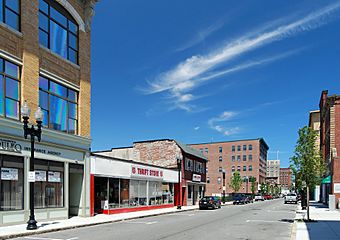Munroe Street Historic District facts for kids
Quick facts for kids |
|
|
Munroe Street Historic District
|
|
 |
|
| Location | Munroe St. between Market and Washington Sts., Lynn, Massachusetts |
|---|---|
| Area | 2.2 acres (0.89 ha) |
| Built | 1889 |
| Architect | Ashton, James; Huntress, J.S., et al. |
| Architectural style | Italianate, Tudor Revival, Beaux Arts |
| NRHP reference No. | 96000952 |
| Added to NRHP | December 2, 1996 |
The Munroe Street Historic District is a special area in downtown Lynn, Massachusetts. It has some of the oldest buildings that survived a huge fire in 1889. This fire destroyed most of Lynn's downtown. The district includes buildings on Munroe Street, between Market and Washington Streets. This historic area was added to the National Register of Historic Places in 1996.
Contents
What is the Munroe Street Historic District?
Munroe Street is in downtown Lynn, just west of the Central Square area. It runs next to the MBTA commuter rail tracks. The train station is on the other side of the tracks. Munroe Street is one block long. It goes from Market Street on the west side to Washington Street on the east side.
Buildings in the District
There are 23 buildings along Munroe Street. All of them were used for businesses or factories. Most are two to four stories tall. They are mostly made of brick. Many were built between 1870 and 1890. Some are older, and some are newer. The buildings look different from each other. They show the popular building styles of their time.
How did Munroe Street become historic?
The city of Lynn was first settled in 1629. But Munroe Street did not have many buildings until the 1800s. A railroad line was built next to Munroe Street in 1840. Market Street was already a crossing point for a nearby stream.
The Shoe Industry and the Railroad
Munroe Street became important for Lynn's shoe industry after the railroad arrived. Businesses grew there because it was easy to move goods by train. At first, there were some homes on the street. But by the late 1800s, shoe factories had replaced all the houses.
Surviving the Great Fire of 1889
The Munroe Street area is famous for surviving the Great Fire of 1889. This fire burned much of downtown Lynn. But the fire stopped before it reached Munroe Street. Because of this, the buildings on Munroe Street show us what Lynn looked like before the fire. They offer a great look into the early history of Lynn's important shoe industry.



